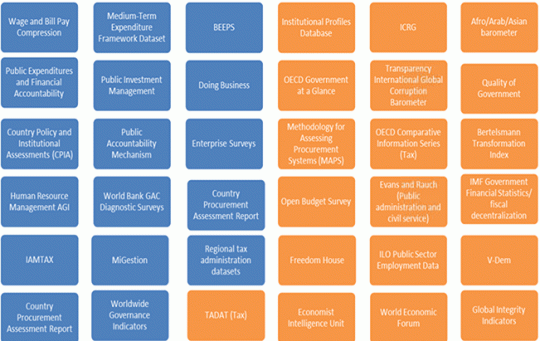 If you are interested in measuring government performance, it’s hard to know where to start.
If you are interested in measuring government performance, it’s hard to know where to start.
Over the past decade, there has been an explosion of indicators that measure governance and public sector performance and processes. Today, there are over 1000 different measures that have been tested across a variety of countries at some point in time. The World Bank Group alone has developed about 20 datasets that include some indicators that touch on various public management topics, from tax administration to public financial management, procurement, and the civil service.
These indicators are designed to monitor and advocate for reform. At the World Bank, we track progress on “effective and accountable government” (an indicator collected by Freedom House) across our client countries and report it in our Corporate Scorecard. The U.S. Millennium Challenge Corporation uses this same indicator (among others) to identify countries that qualify for funding. The Public Expenditure Financial Accountability (PEFA) and the Country Policy and Institutional Assessment (CPIA) are the two datasets of choice for the international community to use to monitor commitments to strengthen and use country systems. Researchers have used the Worldwide Governance Indicators and others to test the importance of institutions to economic growth.
In some aspects, the indicators are quite diverse. They cover a wide range of topics, from how many people file taxes online to whether civil servants act impartially. Some focus exclusively on one public management topic, such as tax administration (e.g. Tax Administration Diagnostic Assesssment Tool or TADAT) or public financial management (e.g. PEFA), while others cover a broad range of government functions. Some look at government performance from the perspective of businesses (Doing Business or Enterprise Surveys), while others ask experts for their views.
However, they almost all have one thing in common: they were developed by a group of wise, knowledgeable experts. These experts predominately work in think tanks, academia, or multi- or bi-lateral development banks. Quite a few have PhDs. Many have decades of experience working to reform governments. And, there are good reasons for using this process. Collecting data is usually an expensive proposition that must be done in a standardized way if results are to be valid and robust across countries.
But, what happens if we turn this process on its head? What happens if we ask citizens and a wider group of practitioners and researchers what types of information they would like to see or have used in the past? The World Bank and a group of partners recently launched the indicators challenge or iChallenge, a competition designed to do just that by crowd sourcing ideas for indicators from the general public.
The
iChallenge came out of an effort by the  World Bank and its partners to compile, make sense of, and build consensus around the myriad of indicators available to measure the core functions of government, including tax, public financial management, procurement, civil service and information management. This effort, called the Indicators of the Strength of Public Management Systems (ISPMS) is looking in particular for indicators that are: [Click on the image to enlarge it]
World Bank and its partners to compile, make sense of, and build consensus around the myriad of indicators available to measure the core functions of government, including tax, public financial management, procurement, civil service and information management. This effort, called the Indicators of the Strength of Public Management Systems (ISPMS) is looking in particular for indicators that are: [Click on the image to enlarge it]
- actionable by governments. We want to measure things that governments can actually do something about, and can be held accountable to change.
- behavioral in that they measure how government actually function, rather than the specific forms that they may take. How many times have governments passed laws and touted the reform process as complete, when nothing really changes on the ground?
- action-worthy because they measure aspects of government functioning that lead to development outcomes that we care about. Giving every civil servant an ipad may raise morale, but does it lead to faster processing times for government payments?
- comparable across countries and time and have been collected regularly.
- replicable by using a transparent methodology and making data publicly available.
The iChallenge aims to complement and build upon this initial set of indicators by using an inclusive process. ISPMS has already taken stock of what indicators are being regularly collected across countries. The task now is to open up the conversation to see what others can recommend. We are literally searching for good ideas from all corners of the globe. We are trying something new. Please join us.
Over the next few weeks, we will have a series of blog posts about how to measure governance and public management systems. This is the first in the series.


Join the Conversation